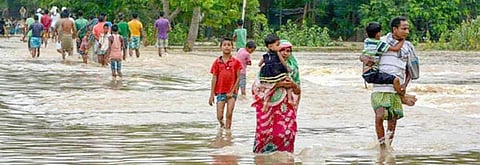

After approximately 300,000 were affected by pre-monsoon floods in 11 districts across Assam, concerns have emerged over the adherence to social-distancing norms to curb the spread of the novel coronavirus disease (COVID-19). Two individuals have died so far, with around 20,000 sheltered in relief camps.
For those who were sheltered in relief camps, social-distancing norms were being adhered to, with arrangements for flood relief being made in line with past experience, said officials. Severe floods during the monsoons could, however, strain the state’s limited resources and make social-distancing difficult in affected areas.
Assam, a flood-prone state, was impacted by floods in 2019 as well, with approximately 1.4 million affected in the span of a week. This time, however, flood relief is compounded with the fact that social-distancing must be maintained in order to not increase the spread of COVID-19.
The number of COVID-19 cases shot up to 880 on May 28, 2020, said Himanta Biswa Sarma, the state’s health minister, on micro-blogging site Twitter. Around 97, mostly those in mandatory quarantine, tested positive as well. There were only 50 cases in the state on May 7, with this number doubling on May 17.
The number of migrants returning to Assam from different states across India prompted the state government to increase testing, with 86,340 tests conducted till May 28.
Floods affected 294,170 across 300 villages and localities spread over 15 revenue circles of nine districts, according to the Assam State Disaster Management Authority (ASDMA) daily bulletin issued late evening on May 28.
As many as 80 relief camps were set up in the state to shelter the affected population.
The Brahmaputra river in Jorhat district of Upper Assam and Kopili in Nagaon district flowed above the danger mark on May 28. The wave of flooding occurred after rainfall in the aftermath of cyclone Amphan.
Goalpara district in lower Assam was the worst-hit, with two deaths and over 200,000 affected in the district, after flash floods first hit neighbouring Meghalaya’s Garo Hills.
Measures taken
“We are ensuring that social distancing norms are followed in the relief camps,” said Varnali Deka, the deputy commissioner of Goalpara.
Deka said all the schools in the district schools were identified to serve as relief camps. There are 1,697 schools in the district, according to officials. Excluding those in flood-prone areas, the remaining may be used to shelter those affected by the flood.
Around 214 such schools-turned-relief camps were identified, according to Deka. Headmasters in these schools will be designated in-charge of the relief camps and apprise officials of their needs and inform them if their camps get overcrowded.
“We will move some people to the next nearest camp by road or boats,” Deka said, adding masks and sanitisers will be given to those in the camps.
She said no cases of COVID-19 or other influenza-like illnesses were found, so far, among those affected, during their medical screening. Any such cases will be tested and put in isolation according to the guidelines, she said.
Earlier this month, ASDMA issued a new set of guidelines to manage flood relief camps in light of the pandemic.
Districts were asked to identify additional relief camps according to the population density of villages to ensure enough space for social-distancing, the guidelines said.
They were asked to ensure an area of seven square metres per person, instead of the earlier 3.5 square metres per person to ensure a space of at least one metre between any two individuals.
MS Manivannan, the chief executive of ASDMA said all districts identified spaces for relief centres in line with the new guidelines. He said while it is difficult to predict the severity of this year’s floods, the state is preparing itself in line with earlier experiences.
In 2019, at least 91 people died after several waves of flooding that began in May, affecting most of the state.
To augment its disaster management capacity, Assam has started a volunteer programme. Approximately 16,000 persons applied to be Pratirodhi Bondhus out of which 14,000 were selected and trained online to help authorities tackle the COVID-19 crisis and flood rescue and relief.
Ravindra Nath, the founder of non-profit Rural Volunteer Centre, said the flood will reach new areas this year. This was because embankments were not developed due to COVID-19.
This year, the government has to deal with the pandemic and the flood.
For rehabilitation, the government has to think about relief material beyond rice and pulses, said Nath. Assam at present, has only 15 boat clinics, a number that is not sufficient at all. The state needed at least 30 boat clinics, he added.
With inputs from Kundan Pandey.